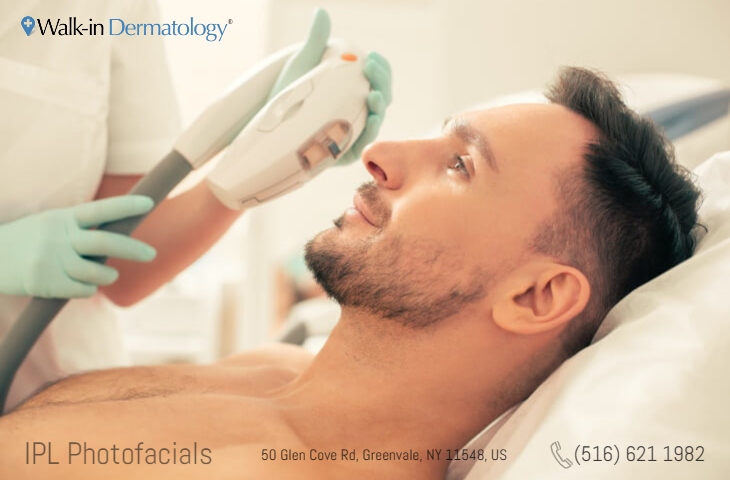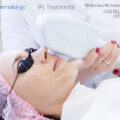Tues: 8:30am - 3:00pm
Wed: 12:00pm - 6:00pm
Thurs: 8:30am - 3:00pm
Fri: Closed
Sat: 8:30am - 12:30pm
Sun: Closed
Greenvale, NY 11548
What’s Better: IPL or BBL?


IPL and BBL are types of light therapies dermatologists use to improve the appearance of your skin. As to which therapy is better, it really depends on the individual patient. Some skin types respond more favorably to one type of light treatment over another.
Let’s take a closer look.
IPL stands for Intense Pulsed Light and BBL stands for Broad Band Light. Both skin revitalization therapies are nonsurgical procedures that work by directing light energy into the skin. The light converts to heat as it reaches its target, which can be pigment in the skin or hair, redness caused by blood vessels, as well as bacteria in acne. The goal of treatment is to remove blemishes and imperfections in the skin, or in severe cases to make them less noticeable. Both IPL and BBL produce excellent results with minimal downtime and discomfort.
Once the heat hits the target it is absorbed, eventually eliminating the target from the skin. As the area heals, the skin produces healthy elastin and collagen, restoring the area to its natural condition. Both treatment types use light filtered at different wavelengths to treat skin conditions and create a more youthful appearance through rejuvenated skin.
Here’s how it works:
Dark spots on the skin are actually tiny pockets of pigment or blood cells that are trapped underneath the skin’s surface. This can be caused by prolonged sun exposure, skin disease and certain injuries. All of these conditions cause the release of excess pigments or blood to heal the inured area. Once the area has healed, the pigment molecules or blood cells don’t disappear. They become trapped in pockets of collagen, which can be seen under the surface of the skin.
IPL and BBL treatments target the cells in those collagen pockets, causing them to break apart so they disappear during the healing process. The result is even-toned, unmarred skin.
IPL and BBL over more than 10 years have become an effective method for reducing signs of aging, including treatment of sun damaged skin (also known as photodamage), fine lines and wrinkles, vascularity (reddening of the skin caused by blood vessels), skin texture and other cosmetic concerns. The number of treatments necessary to achieve the desired results varies from patient to patient, although immediate improvement is often seen in as little as 1 to 3 treatments. Each session is typically scheduled 3 to 4 weeks after the previous session.
IPL and BBL work on the same concept of pulsing light to achieve photo rejuvenation, but there are several differences.
IPL was one of the first photo-rejuvenation technologies. Today IPL is used to treat:
- Sun spots
- Rosacea
- Scarring
- Dilated blood vessels
- Enlarged pores
The range of light waves in an IPL treatment target hemoglobin and melanin in the skin, eliminating these spots of hyperpigmentation. IPL light waves also gently heat the deeper layers of skin, stimulating collagen production. This reduces the appearance of fine lines and scars.
BBL is a more advanced version of IPL therapy, both in terms of accuracy and targeting specific skin conditions for treatment:
- Skin tone and texture
- Acne
- Pigmentation
- Sagging skin
- Birthmarks
- Freckles
- Age spots
- Broken capillaries
- Bruising
- Rosacea
- Aging skin
BBL targets skin imperfections at the source, far below the surface of your skin. The technology stimulates new cell growth, which forces the skin to repair itself. As these deeper layers of cells rise to the surface, your skin will continue to improve.
This process fades discolorations and stimulates collagen growth for smoother, firmer skin with a more even tone and a decreased appearance of wrinkles and fine lines. There are other benefits as well.
Studies show that BBL can stop the clock on the appearance of aging skin. How does it work? First, a brief look at microbiology. The DNA in our cells determine what each cell is going to be as it grows and how it’s supposed to function. As we get older, our DNA becomes damaged. Cells become less effective in following the instructions of our DNA. Skin cells with older DNA do not replenish with new cells as fast as they once did. So older skin cells remain on the surface longer, creating dull, dry-looking skin.
BBL treatments rejuvenate the genetic code in skin cells. As a result, cells with rejuvenated DNA perform like younger cells. Soon, your skin begins to look younger as the deeper, BBL-treated layers rise to the surface.
Who’s a candidate for light therapy?
It’s important to know that patients cannot be treated with BBL if they have an active herpes infection, open wounds or skin injuries. Sunburn, certain types of scarring, skin infections or skin cancer would also eliminate BBL as a treatment option until those conditions are resolved.
Additionally, women who are pregnant or breastfeeding should not perform BBL treatment.
BBL also cannot be done for at least 4 weeks following sunburn, unprotected sun exposure or use of a tanning bed.
Generally, BBL treatments are more effective in people with darker skin types. BBL is also preferred for certain skin conditions, as highlighted above.
Another advantage of BBL is fewer treatments may be required to achieve results compared to IPL, in some cases perhaps half as many.
What comes after treatment?
With either therapy, you’ll need to avoid prolonged sun exposure for at least 4 weeks prior to treatment. At the same time, you’ll need to apply sunscreen daily (our dermatologists usually recommend sunscreen with at least SPF 30).
Down time after light-therapy treatment is usually minimal, but there are precautions to take. Your skin will be sensitive and may feel like it has been sunburned. Until that sensation goes away, you should avoid:
- Showering, swimming, hot tubbing, saunas or vigorous exercise for at least 24 hours
- Applying makeup over the treated areas
- Using scented soaps or lotions, deodorants, and active skin care ingredients that contain retinol and glycolic acids
- Sun exposure and tanning beds
Your dermatologist may recommend a specially formulated recovery cream for you to apply to your skin after treatment.
As with any technologically advanced therapy, the skill of the IPL and BBL operator is just as important as the equipment. This is why you should review the credentials and experience of any aesthetician or dermatologist you are considering for these cosmetic procedures. Verify that they use medical-grade equipment, which cannot be operated by amateurs. Another factor to consider is price. If you are offered a rock-bottom deal on either IPL or BBL procedures, you can bet that corners are being cut somewhere, either in the skill of the operator or the quality of the equipment.
Getting the best treatment
The good news is you don’t have to look far for excellent cosmetic dermatology services – and now there’s no waiting.
In many parts of New York and throughout the country, patients often have to wait weeks before they can see a board-certified dermatologist.
That’s no longer necessary.
At Walk-in Dermatology, patients can see a board-certified dermatologist seven days a week. Our dermatologists will evaluate your skin and, if light therapy seems like the right solution, will work with you to determine whether IPL or BBL treatment is best for you.
No more waiting days or even weeks to receive light therapy treatments. If you are seeking a non-surgical way to revitalize your appearance and treat sun damage, address wrinkles and fine lines, help with rosacea, enlarged pores, scars and more, Walk-in Dermatology is ready to serve you.
Learn more: How Long Does it Take for Brown Spots to Fade after IPL?








